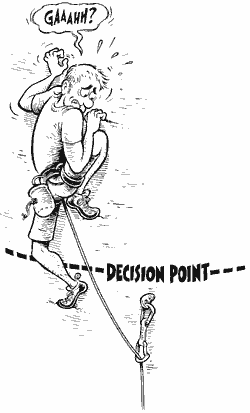Climb Because It’s Hard, And Four Other Tips For Success
This article originally appeared on Climbing
Get hands-on learning straight from Arno Ilgner in Climbing’s online video-course The Art of Redpointing. In this comprehensive class you’ll learn how to pick the right project, train your mind and body, refine your beta, and execute effective burns for a successful redpoint send. Sign up now, learn from home, and climb your level best.
Commitment: What causes it to stay high or to drop? "Until one is committed there is always hesitancy, a chance to draw back, always ineffectiveness." So begins a frequently quoted passage from W.H. Murray's book Scottish Himalayan Expedition. Commitment can carry you through difficult climbs, while lack of it can shut you down. What allows some climbers to tap into this resource and others not? Commitment isn't something that some climbers have and others don't. Rather, those climbers who are able to commit apply their attention differently. There's a time to prepare and a time to act. Commitment comes into the mix when you transition from preparing to acting -- from thinking to doing. Great things transpire here, but the quality of your commitment will depend on how you negotiate this transition. As you get on climbs near your limit, you increase the likelihood of falling. On hard routes you'll be faced with a decision: commit to climbing or, if the falling consequence isn't safe, retreat. Practice commitment by selecting and engaging safe, well-protected climbs, as you'll likely be whipping.
Avoidance behavior: Most climbs are broken into easier sections and crux sections. Avoidance behavior is common when you enter a crux -- you seek an escape from the anxiety and fear caused by the very challenging climbing and the reality that you might fall. Remember that you're on a hard climb in order to challenge yourself, not to get off easy. Embrace the difficulty, don't avoid it.
Also Read
Dynamics of the break. Anxiety and fear will remain until you deliberately break away and commit. Below each crux section is a decision point. When you're poised below a crux, your attention is focused on gathering information and weighing options. When you take action you'll stop thinking and focus your attention on acting on those options. This shift should be abrupt and complete. Convince yourself that there are only two possible outcomes -- you will climb through or you will fall. Then, commit! Engage the climbing. By fully accepting the falling outcome, you reduce the intrusion of the thinking mind and eliminate the tendency to second-guess yourself.
Expectations. The type of expectation you have will either empower your commitment or weaken it. When you launch into the crux sections you should expect that it will be uncomfortable. Beyond that, keep your expectation on the effort, not the outcome. This will keep your attention focused on the quality of your climbing. An effort focus allows you to learn, because you get useful feedback about your performance rather than the "pass/fail" grade you get if you're focused on the outcome. Your commitment stays high because you receive what you want -- feedback and learning -- each step of the way.
Executing moves with a decisive mind and effort-based expectations will boost your chance of success.

Motivation. Your type of motivation also will impact your commitment. With a fear-based motivation -- fear of falling, failure, or loss of control -- you enter the crux with an attitude of avoidance. You're focused on what you don't want to happen. Instead, cultivate a positive motivation. What do you like or enjoy about a challenging climb? The outcome may be uncertain, but you do know that you can engage. Set your intention on engaging and exerting effort.
Apply your knowledge. First, identify the transition points -- those places below crux sections. Assess the consequences of a fall and accept them. Third, stay positive in your motivation by looking for possibilities. Last, be decisive. Create a break by committing to a crux. Set an intention to engage the risk and keep your expectation focused on exerting effort. Commit to a single course of action -- simply stop thinking and go for it!
Arno Ilgner teaches his Warrior's Way mental training classes in the Southeast and at various climbing gatherings around the country. You can contact him at www.warriorsway.com.
For exclusive access to all of our fitness, gear, adventure, and travel stories, plus discounts on trips, events, and gear, sign up for Outside+ today.


